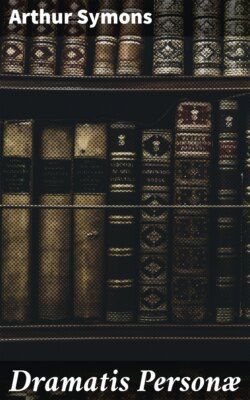Dramatis Personæ

Реклама. ООО «ЛитРес», ИНН: 7719571260.
Оглавление
Symons Arthur. Dramatis Personæ
Dramatis Personæ
Table of Contents
I
II
III
MAURICE MAETERLINCK. I
II
EMILY BRONTË
ON ENGLISH AND FRENCH FICTION. I
II
III
IV
ON CRITICISM
THE DECADENT MOVEMENT IN. LITERATURE
THE ROSSETTIS
CONFESSIONS AND COMMENTS. I
II
FRANCIS THOMPSON. I
II
III
COVENTRY PATMORE
SIR WILLIAM WATSON
EMIL VERHAEREN
A NEGLECTED GENIUS: SIR RICHARD. BURTON. I
II
III
IV
V
EDGAR SALTUS
RECOLLECTIONS OF RÉJANE. NOTES ON THE ART OF THE GREAT FRENCH. ACTRESS
RÉJANE IN "MA COUSINE"
MELODRAMA WITH AN IDEA
"MADAME SANS-GÊNE"
THE IRONIC COMEDY OF BECQUE
"LA ROBE ROUGE"
THE RUSSIAN BALLETS. I
II
III
ON HAMLET AND HAMLETS
LEONARDO DA VINCI. I
II
III
IV
IMPRESSIONISTIC WRITING
PARADOXES ON POETS
Отрывок из книги
Arthur Symons
Published by Good Press, 2021
.....
In comparing the author of La Princesse Maleine with Shakespeare, Mirbeau probably accepted for a moment the traditional Shakespeare of grotesque horror and violent buffoonery. There is in Maleine something which might be called Elizabethan—though it is Elizabethan of the school of Webster and Tourneur rather than of Shakespeare. But in L'Intruse and Les Aveugles the spiritual terror and physical apprehension which are common to all Maeterlinck's work have changed, have become more interior. The art of both pieces consists in the subtle gradations of terror, the slow, creeping progress of the nightmare of apprehension. Nothing quite like it has been done before—not even by Poe, not even by Villiers. A brooding poet, a mystic, a contemplative spectator of the comedy of death—that is how Maeterlinck presents himself to us in his work, and the introduction which he has prefixed to his translation of L'Ornement des Noces Spirituelles of Ruysbroeck l'Admirable shows how deeply he has studied the mystical writers of all ages, and how much akin to theirs is his own temper. Plato and Plotinus, Saint Bernard and Jacob Boehme, Coleridge and Novalis—he knows them all, and it is with a sort of reverence that he sets himself to the task of translating the astonishing Flemish mystic of the thirteenth century, known till now only by the fragments translated into French by Ernest Hello from a sixteenth-century Latin version. This translation and this introduction help to explain the real character of Maeterlinck's dramatic work—dramatic as to form, by a sort of accident, but essentially mystical. As a dramatist Maeterlinck has but one note—that of fear; he has but one method—that of repetition. This is no equipment for a Shakespeare, and it will probably be some time before Maeterlinck can recover from the literary damage of so incredible a misnomer.
In the preface to the first volume of the collected edition, which should be read with attention by all who are interested in knowing Maeterlinck's opinion of his own work, we are told:—
.....